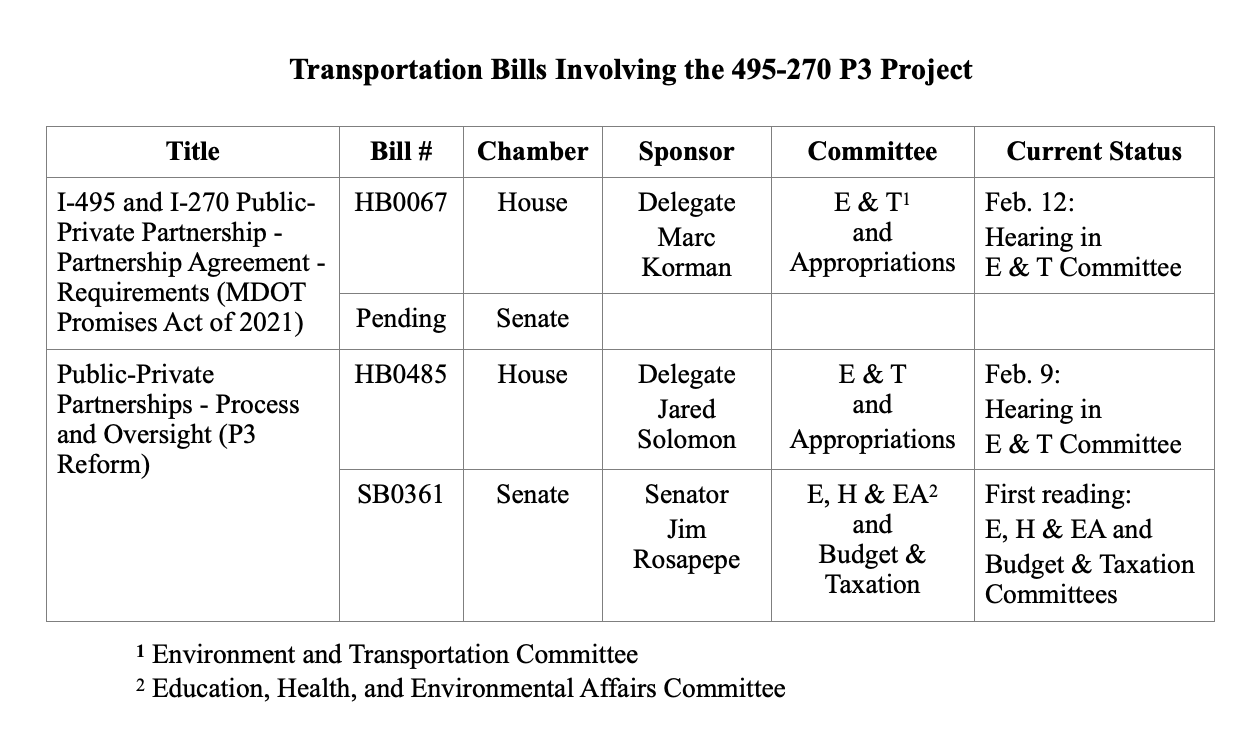The Maryland Department of Transportation (MDOT) is rushing ahead with its ill-conceived project.
MDOT is about to seek Maryland Board of Public Works (BPW) approval of a contract for a Phase Developer to begin pre-development design. For the contract to move forward, two of the three BPW members must approve it. Since the project is Governor Hogan’s creation, we know how he will vote. Treasurer Nancy Kopp is likely to vote against it. Comptroller Peter Franchot is the swing vote.
Action Item
Write BPW members Comptroller Franchot at pfranchot@comp.state.md.us and Treasurer Kopp at treasurer@treasurer.state.md.us.Tell them that no P3 agreement should be approved by the BPW until the Final Environmental Impact Statement (FEIS) is complete.
According to the BPW’s website, their mission is to protect and enhance the State's fiscal integrity by ensuring that significant State expenditures are necessary and appropriate, fiscally responsible, fair, and lawful.
As stewards of the State’s finances, the three BPW members must consider the costs this project will incur. Governor Hogan promised there would be no net cost to taxpayers for the toll lane project. But Public-Private Partnerships (P3s) are designed to monetize traffic, and they rely on taxpayer subsidies.
Maryland may be stuck with hundreds of millions of dollars in expenses and future outlays. P3s regularly burden taxpayers with high costs, often unexpected.
There are huge on-going MDOT-State Highway Administration (MDOT-SHA) expenses and staff costs paid for with taxpayer funds.
The Draft Environmental Impact Statement (DEIS) estimated that Alternative 9 (described below), MDOT’s preferred alternative, might require the State to provide a subsidy of up to $482 million to the P3 contractor (refer to DEIS pp. 2-48).
According to a Washington Post article, “Maryland Could Face Millions in Cost Risks” , the State would be obligated to pay the contractor up to $50 million for ‘pre-development costs’ if the project does not move forward as planned.
Taxpayers may have to pay up to $2 billion to move water and sewer lines.
Selection of Preferred Alternative
On Jan. 27, MDOT announced it had selected Alternative 9 from the list of build options.
Alternative 9 would convert the existing high occupancy vehicle (HOV) lanes on I-270 to high occupancy toll (HOT) lanes and add one managed lane in each
direction. Vehicles with 3 or more people would be able to travel free of charge, a change from current HOV lane regulations that – during rush hours -- permit travel by vehicles with 2 or more people only.
The conversion of the current HOV lanes to toll lanes would effectively remove one free lane in each direction; the current HOV lanes cost nothing and are restricted to HOV for only a short portion of the day.
The plan would place the toll lanes in the middle of the highway. As reported in a Maryland Matters article, MDOT believes much of the project can be done within I-270’s existing walls. However, what is unknown is how much land will be needed to build off-ramps to connect toll-lane users with local roads.
For more information on the Preferred Alternative, go to the Dontwiden270.org website tab “Media Archives” and click on the articles listed for Jan. 27, 2021.
Dontwiden270.org Testimonies
Dontwiden270.org coordinators and other advocates often provide testimony at legislative meetings and hearings opposing the I-495 & I-270 P3 project. Recently, several individuals spoke at City of Rockville Mayor and Council meetings. Their testimonies informing the Mayor and Council members of current issues about the P3 and widening I-270 can be found at the Dontwiden270.org website tab “Resources.”
Worth Reading
D.C.-Area Planning Board Slams Hogan Administration Plan for Widening Capital Beltway, I-270, Maryland Matters:
The leaders of the Maryland-National Capital Park and Planning Commission (M-NCPPC) “slammed the state’s” plan to widen parts of the Capital Beltway and Interstate 270 .
Opinion: Rushing Beltway construction won’t solve Maryland’s congestion problem, Washington Post:
“Among the wasteful highway boondoggles still moving forward…, few would harm local residents’ health more or cause greater, irreversible environmental damage than Maryland’s Capital Beltway project…”
A Rare Request for Donations for a Valued Partner
We often receive e-mails from you, our readers, thanking us for the valuable information in our newsletters. We thank you!
Some of you have offered to help cover our costs, but we are not set up to receive donations. However our valued partner, the Maryland Transit Opportunities Coalition (MTOC), which provides us with technical understanding that enables us to give you accurate information, can take donations. MTOC is an invaluable center of technical and policy expertise on transit and equitable transportation. MTOC uses donations to help cover its website expenses, printing of fliers, and more. If you are able to help them, we would be very grateful.
To make a donation of any size, online or by check, kindly follow this link: https://transitformaryland.org/contribute. Thank you!
There’s Strength in Numbers. Please Help us Grow Our Mailing List
People who read our newsletters take action, and our elected officials take notice! Help spread the word about what we can do to safeguard our environment and promote healthy, efficient, and fair transportation options.
Tell your friends and neighbors they can join our newsletter e-mail list by going to https://dontwiden270.org/get-involved and checking the "keep me informed" box. Our website is https://dontwiden270.org/.




